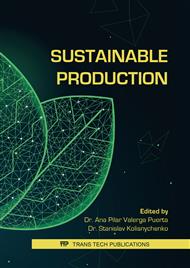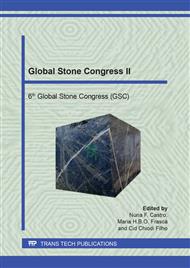[1]
F. S. Braga; D. C. Buzzi, M. C. L. Couto; L. C. Caracterização ambiental de lamas de rochas ornamentais. Eng. Sanit. Ambient. 15 (2010) 237–244.
DOI: 10.1590/s1413-41522010000300006
Google Scholar
[2]
ASTM-American Society for Testing and Materials. Standard terminology relating to dimension stone. ASTM C119/16. (2016).
Google Scholar
[3]
I. Ashmole, M. Motloung, Dimension stone: the latest trends in exploration and production technology, in: Proceedings of the International Conference on Surface Mining. (2008) 5–8.
Google Scholar
[4]
Careddu, N, Rough surface finishing of stone-faced sandwich panels using high pressure waterjet. J. Mater. Civ. Eng. 24 (2012) 907–915.
DOI: 10.1061/(asce)mt.1943-5533.0000468
Google Scholar
[5]
L. Nogami, A. B. Paraguassú, J. E. Rodrigues, Fixação de placas de rochas ornamentais: estudo da aderência com argamassa colante. Minerva magazine. 5 (2008) 45-42.
DOI: 10.11606/d.18.2007.tde-07052008-085848
Google Scholar
[6]
F. Xi, D. Zhou, Modeling surface roughness in the stone polishing process. I. J. of Machine Tools and Manufacture. 45 (2005) 365-372.
DOI: 10.1016/j.ijmachtools.2004.09.016
Google Scholar
[7]
I. M. Hutchings, K. Adachi, Y.Xu, E. Sánchez, M.J. Ibánez, M.F. Quereda, Analysis and laboratory simulation of an industrial polishing process for porcelain tiles, J. Eur Ceram Soc. 25 (2005)3151–3156.
DOI: 10.1016/j.jeurceramsoc.2004.07.005
Google Scholar
[8]
P.F. Almeida, V.M. Ponciano, L. L. L. Silveira, E. P. Sichieri. Insertion of silicon carbide as cutting element in ecological fickerts for dimension stone polishing. Proceedings of VI Global Stone Congress. (2018) 239-242.
DOI: 10.4028/www.scientific.net/kem.848.28
Google Scholar
[9]
M.R. Beserra, J.A Schiavini, W.C. Rodrigues, C.S.S. Pereira, Bisfenol A: Sua utilização e a atual polêmica em relação aos possíveis danos à saúde humana. TCCEN E-publishing. 5 (2012) 37-46.
DOI: 10.21727/teccen.v5i1.108
Google Scholar
[10]
J. F. Mendoza, M. Feced, G. Feijoo, A. Josa, X. Gabarrel, J. Rieradevall, Life-cycle assessment of cladding products: A comparison of aluminum, brick, granite, limestone, and precast concrete, Int J Life Cycle Assess. 19 (2014) 153-165.
DOI: 10.1007/s11367-013-0637-6
Google Scholar
[11]
M.C. Aydin, E. Isik, A. E. Ulu, Emerging sustainable/green cleaning products: health and environmental risks. J Current Construction Issues. 11(2016) 174-182.
Google Scholar
[12]
L.L.L. Silveira, Patent BR 10 2012 032157-2 A2, (2015).
Google Scholar
[13]
V.M.F. Leitão, L.L.L. Silveira, Ecoabrasivo confeccionado com resina vegetal e carbeto de silício: uma inovação para o setor de rochas ornamentais In: Proceedings of the XXII Scientific Initiation Journey. Rio de Janeiro, Brazil. 21 (2014), 4p.
Google Scholar
[14]
W. F. G. Dorigo, L. L. L. Silveira, Contribuição da sílica oriunda da queima da palha do arroz no aumento da resistência à abrasão de compósito vegetal. In: Proceedings of the XXIV Scientific Initiation Journey. Rio de Janeiro, Brazil. 24 (2016), 4p.
DOI: 10.19146/pibic-2016-51377
Google Scholar
[15]
V.P. Della, I. Kühn, D. Hotza, Characterization of rice hull ash for use as raw material in the manufacture of silica refractory. Química Nova, 24(6) (2001) 778-772.
Google Scholar
[16]
I. J. Fernandes, D. Calheiro, E.C.A. Santos, T.L.A.C. Rocha and C.A.M. Moraes, Comparação de cinza da casca de arroz e sílica comercial como carga em compósitos poliméricos. In: Proceedings of XXI CBECIMAT. (2014) 2665-2672.
DOI: 10.11606/t.85.2009.tde-23092009-145638
Google Scholar
[17]
ASTM-American Society for Testing and Materials. Standard guide for conducting wear tests using a rotary platform abraser. ASTM G195/18. (2018).
DOI: 10.1520/g0195
Google Scholar



